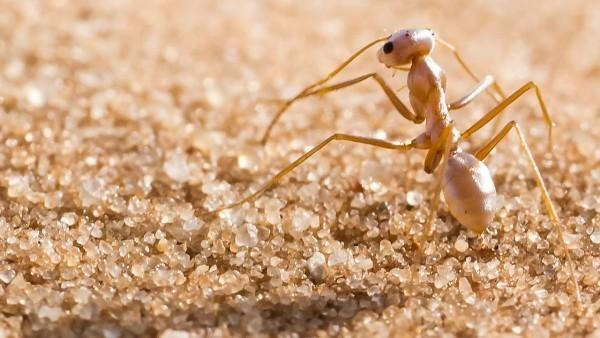How Silver Ants Use Hair Like NASA's New Heat Shield Tech
The Saharan Silver Ant is discovered to dissipate heat using shiny silver hairs covering its entire body. Norman Nan Shi, assistant professor of applied physics at Columbia Engineering, has shown that the hairs of the Saharan Silver Ant act like heat shields, not entirely unlike NASA's space suit materials being developed for use by firefighters here on Earth. These ants live in an environment which can get extremely hot, up to 70°C (158°F). To make due when they need to forage for food, they've developed a rather intense bit of natural resistance, making them as shiny as they are cool.
The Saharan silver ant (Cataglyphis bombycina) can forage for food in the Saharan Desert in the full midday sun. That's one of the hottest places at that time of day in the world. The ant's "critical thermal maximum" is 53.6°C (128.48°F). As you'll see above, without their specialized super shiny hair, these ants don't stand a chance.

ABOVE: Image via Norman Nan Shi, Nanfang Yu, Columbia Engineering.
Lead Image Credit: "Thermodynamic figure comparing the temperature of ant head with and without hairs. The hair coating helps reduce body temperature substantially (via enhanced reflection of solar radiation and enhanced thermal radiation)." Image via Norman Nan Shi and Nanfang Yu, reconfigured by SlashGear for publication.
"This is a telling example of how evolution has triggered the adaptation of physical attributes to accomplish a physiological task and ensure survival," said study co-author Nanfang Yu, assistant professor of applied physics at Columbia Engineering, "in this case to prevent Saharan silver ants from getting overheated."
With this shiny hair, the ant's body temperature is 5 to 10 degrees cooler than without. Of course these ants live their entire life WITH the hair, so they don't really know what it is to be too hot.

What does NASA have that compares to the hairs on this 10 mm (3/8 inch) long creature?
Just yesterday NASA's Langley Research Center in Hampton, Virginia showed how they were working with the US Department of Agriculture's Forest Service on a new application for space craft tech.
As you'll see in the video here, they're using flexible, metallic material to divert heat. This material in an earlier form was originally intended for use in space by spacecraft of all sorts.
These scientists are on similar pages when it comes to evolving the technologies we use today via inspiration from nature's most innovative creatures.
"Organs evolved for perceiving or controlling electromagnetic waves often surpass analogous man-made devices in both sophistication and efficiency," said Yu. "Understanding and harnessing natural design concepts deepens our knowledge of complex biological systems and inspires ideas for creating novel technologies."

IMAGE CREDIT: Ramy Maalouf
"Such biologically inspired cooling surfaces will have high reflectivity in the solar spectrum and high radiative efficiency in the thermal radiation spectrum," said Yu.
"This may generate useful applications such as a cooling surface for vehicles, buildings, instruments, and even clothing."
More information can be found in the paper "Keeping cool: Enhanced optical reflection and heat dissipation in silver ants" in the scientific journal "Science" this month. This paper was authored by Norman Nan Shi, Cheng-Chia Tsai, Fernando Camino, Gary D. Bernard, Nanfang Yu, and Rüdiger Wehner.
